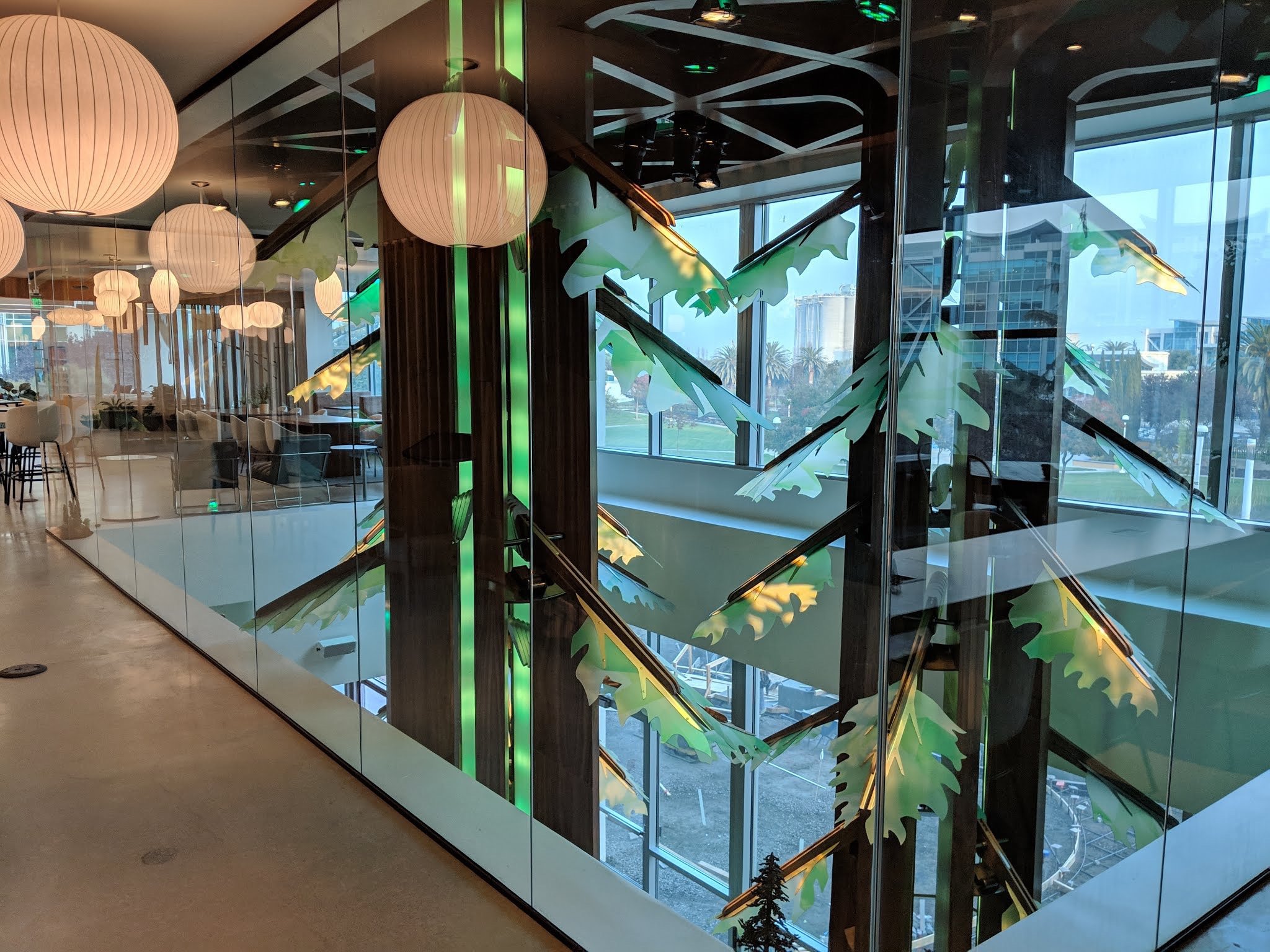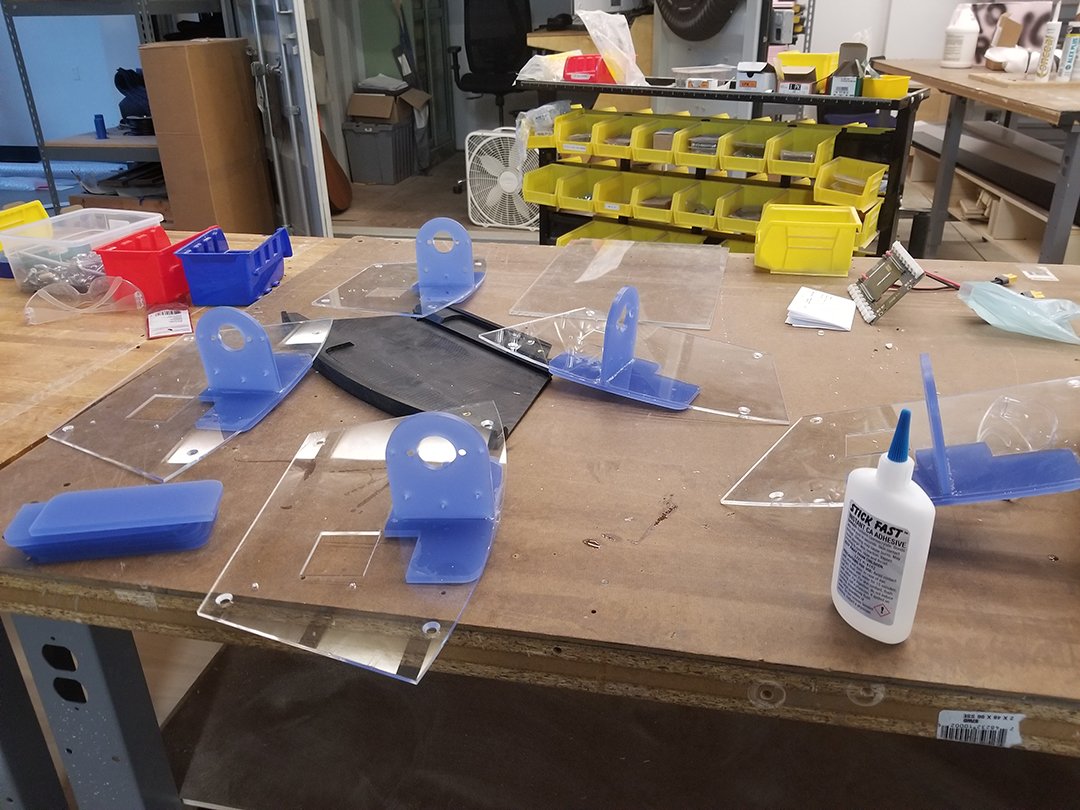
Google Redwood City - Grove
Dec 2017 - November 2018
This project was created for the Google ‘Grove Experience Center’ in Redwood City, California.
The centerpiece of this facility is a two-story tall assembly of programmable ‘Redwood Trees’ with matching ‘canopy’. The trees are adorned with programmable lighting arrays and dozens of individually addressable motorized branches capable of simulating a breeze blowing through the space and rustling the foliage.
I contributed the final designs and all fabrication for the branches based on an initial sketch from the experience design firm Thinkwell. Central ‘tree trunks’ and designs for sub-assemblies were created by Zach Ali. The ceiling assemblies were designed primarily by Carl Bajandas, with some of the procedural generation being assisted by Greg King.
These reference documents including all mechanical drawings were created by me at the conclusion of the project to provide both internal and client facing documentation for the components and the process for assembly and disassembly.
The client for this project was intent on there being movement in the tree branches. This is a video of an early prototype showing the motor and cam system (contributed by Visionary Effects) integrated with the rest of the design. This system would be controllable with the same interface that one would program the lights on the ‘trees’ of the grove.
Fabrication for this project took place over the 2018 calendar year. Initial assembly took place in the Iontank studio. One factor complicating this build was that the building where the Grove would be permanently installed was still under construction while each of these works were being designed a built. Due to this complexity it became necessary to have a staff member at the building site site measuring the completed structure to ensure they matched with architectural drawings, Throughout the project we were also coordinating with other building trades such as electricians and flooring teams so that our work wouldn’t conflict with their schedules.
After working with the design firm ‘Thinkwell’ (Now TAIT) to establish a rough concept digital prototyping allowed us to get a sense of the assembly and aesthetics without consuming the time and materials required to create physical prototypes.
One early change made after discussions around digital prototyping was to alter the steel counterweights on the rear of the branches. This component was designed to reduce strain on the motors and cam. The counterweight assembly could potentially be as heavy as 40 pounds. When installed, these parts would hang 11 - 26 feet in the air. Rather then horse-shoe shaped weights we opted to close that slot in the bottom. The alteration to the design resulted in a more complex installation process but provided a more secure attachment in the event of seismic events or catastrophic failure.
Once digital design work and small scale prototyping were approved by the client we had a very large production job ahead. Three trees were planned and close to ~20 branches were to be installed in total around those trees. Each assembly was built of dozens if not hundreds of parts that had to seamlessly fit together and also integrate with the electronics and and software necessary to program and customize these structures on site.
Fabrication of large numbers of metal parts was outside the capabilities of our workshop so that work was contracted to a local supplier. The pieces that took the longest and created the biggest headache were the 3/4" steel and aluminum counterweights. The proofs were waterjet from 3/4" aluminum plates and initially fit together flawlessly. But would later encounter tolerance issues.
The ‘Foliage Supports’ act as the rigid aluminum spine for the acrylic ‘Leaf Panels’ which had designs printed directly onto the translucent plastic. This part was laser cut from 3000 series aluminum and bent on a metal brake. 100 of these parts were made. They were mirror images of each other: 50 left, 50 right. This rigid metal spine interfaced with the wooden ‘branches’ and was designed to be highly adjustable which enabled fine-tuning the center of gravity on each branch. This significantly reduced stress on the motors.
Concurrently with metal parts fabrication we were working to machine the branch ‘Limbs’ from 1/2" plywood on our in house CNC machine. All substrate for this project needed to be fire retardant to match building standards.
Some parts were veneered in-house; for others, we hired additional help. This job was too big to be handled by our small team alone.
All of the branch limbs were finished with a sealer coat and 3 coats of polyurethane on the veneer. Polyurethane was applied with an HVLP Gun allowing this process to be greatly sped up. Between each coat they were sanded with high grit sandpaper and the dust was removed with mineral spirits and tack cloths.
100 branch limbs were produced, in only two mirrored profiles which became a core component in varying large, medium and small branches. Simplifying designs and ensuring that all the parts for this project be modular saved us from having issues down the if and when damage would occur from installation shipping or improper handling.
Although not part of our original brief our client wanted us to enclose some of the steel structural members that held together the vertical ‘tree’ pillars. This would hide all the exposed structural steel from view in the final product. To strictly adhere to UL restrictions on electronics enclosures and the aesthetic preferences of the client, it became necessary to redesign the system for holding our motor/controller assembly on each branch.
Here is the mockup of the system that we eventually implemented.
Each 'column' of every tree was secured to those next to it by steel lateral braces, which also served as the mounting point for the branch. Installation of these parts proved to be more difficult then originally anticipated and the decision was made to cover them rather then try and apply finish directly to the steel. These 'plates' would encircle the brace and hold the motor for each branch where necessary.
Prototypes were created of this new ‘motor plate’ enclosure assembly and how it would be installed. One important goal for this sub assembly was to encompass the steel brace without modifying it. The design of the vertical pillars had already gone through engineering review and we were not authorized to make changes to the approved drawings. So installing the plate around the existing brace without the use of additional fasteners would allow it to retain it's full strength as approved by the firm overseeing this project.
Prototype motor plate and electronics enclosure- carved in rigid polyurethane board
Prototype motor plate tops, laser cut out of acrylic sheets.
Final motor plate assemblies were fabricated from solid ABS plastic. This was a material we could easily fabricate in house and could be more easily coated with the approved automotive paint.
Cutting the required ~80 plates for this part of the project took close to 30 hours of continuous milling time. Plates were fabricated in small, medium and large sizes to correspond to the tree they would be installed into.
One final branch assembly was created on site in Pittsburgh to confirm the fit and finish of all the pieces. 6 different profiles of plastic leaves were created each needing different extensions of the 'foliage supports' and different configurations of aluminum and steel counterweights to ensure a light touch on the cam.
Once on site the configuration of each branch was decided by the overall grove project lead. Larger leaves would be up top and smaller leaves closer to the viewer on the ground. Branches were assembled and the counterweight adjustment was tested. Branch installation was the last component to go into the trees and needed to be installed concurrently with two access panels that helped with servicing the electronics of the trees.
While not delicate a lot of care needed to be taken while assembling these parts because the facility was still an active construction zone for much of our installation period.
Branches were installed into the free-standing grove 'tree’ trunks via aerial lift once they were fully assembled. They were then secured in place with a steel insert to prevent any lateral movement, especially critical in this earthquake prone area.









